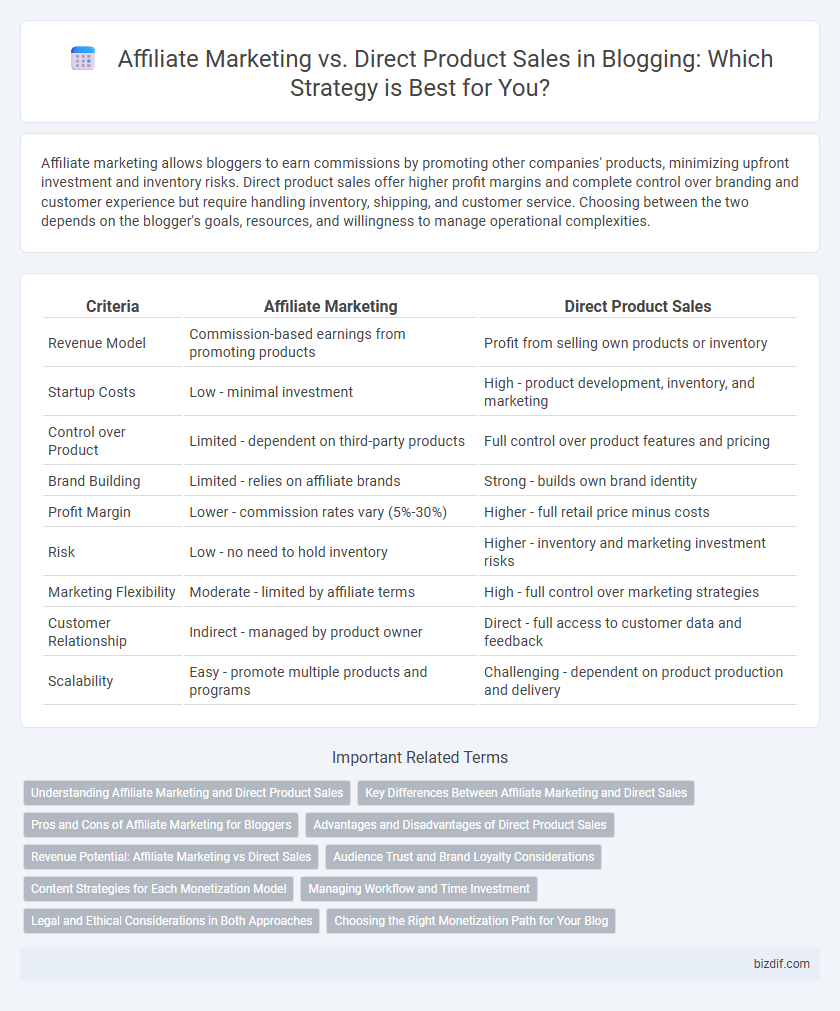Affiliate marketing allows bloggers to earn commissions by promoting other companies' products, minimizing upfront investment and inventory risks. Direct product sales offer higher profit margins and complete control over branding and customer experience but require handling inventory, shipping, and customer service. Choosing between the two depends on the blogger's goals, resources, and willingness to manage operational complexities.
Table of Comparison
| Criteria | Affiliate Marketing | Direct Product Sales |
|---|---|---|
| Revenue Model | Commission-based earnings from promoting products | Profit from selling own products or inventory |
| Startup Costs | Low - minimal investment | High - product development, inventory, and marketing |
| Control over Product | Limited - dependent on third-party products | Full control over product features and pricing |
| Brand Building | Limited - relies on affiliate brands | Strong - builds own brand identity |
| Profit Margin | Lower - commission rates vary (5%-30%) | Higher - full retail price minus costs |
| Risk | Low - no need to hold inventory | Higher - inventory and marketing investment risks |
| Marketing Flexibility | Moderate - limited by affiliate terms | High - full control over marketing strategies |
| Customer Relationship | Indirect - managed by product owner | Direct - full access to customer data and feedback |
| Scalability | Easy - promote multiple products and programs | Challenging - dependent on product production and delivery |
Understanding Affiliate Marketing and Direct Product Sales
Affiliate marketing involves promoting other companies' products through unique tracking links, earning commissions on sales generated, while direct product sales require bloggers to create, manage, and sell their own products, retaining full revenue but incurring higher upfront costs. Affiliate marketing offers scalability and lower risk, with platforms like Amazon Associates and ShareASale providing access to diverse product catalogs. Direct sales demand investment in inventory, customer service, and marketing but enable complete control over branding and profit margins.
Key Differences Between Affiliate Marketing and Direct Sales
Affiliate marketing involves promoting third-party products and earning a commission on sales, while direct product sales require owning inventory and handling customer transactions. Affiliate marketers benefit from lower upfront costs and reduced risk, whereas direct sellers have full control over branding, pricing, and profit margins. The choice depends on factors such as business model, investment capacity, and desired level of control over the sales process.
Pros and Cons of Affiliate Marketing for Bloggers
Affiliate marketing offers bloggers low startup costs and the benefit of passive income through promoting products without handling inventory or customer service. It can limit control over product quality and pricing, potentially impacting trust and revenue consistency. However, the flexibility to choose diverse affiliate programs enables bloggers to tailor content to specific niches while earning commissions on successful referrals.
Advantages and Disadvantages of Direct Product Sales
Direct product sales empower bloggers with full control over pricing, profit margins, and customer relationships, enabling brand building and long-term loyalty. However, managing inventory, fulfillment, and customer service introduces operational complexities and higher upfront costs. This method offers maximum revenue potential but requires significant time investment and risk management compared to affiliate marketing.
Revenue Potential: Affiliate Marketing vs Direct Sales
Affiliate marketing offers scalable revenue potential through commissions generated from promoting various products, often requiring lower upfront investment and less inventory risk. Direct product sales provide higher profit margins per unit sold, driven by full control over pricing and customer experience, but typically demand more initial resources and logistics management. Choosing between the two depends on the blogger's capacity for marketing, product sourcing, and long-term business goals targeting profitability and growth.
Audience Trust and Brand Loyalty Considerations
Affiliate marketing leverages trusted influencers and bloggers to promote products, enhancing audience trust through personalized recommendations and authentic content. Direct product sales allow brands to maintain complete control over product quality and customer experience, fostering stronger brand loyalty by building a consistent and reliable purchasing environment. Choosing between these methods depends on whether prioritizing audience trust through third-party endorsements or direct engagement for long-term brand loyalty is more aligned with business goals.
Content Strategies for Each Monetization Model
Affiliate marketing content strategies emphasize in-depth product reviews, comparison articles, and trust-building tutorials to drive conversions through referral links. Direct product sales benefit from tailored content focused on showcasing unique product features, customer testimonials, and limited-time offers to create urgency and boost direct purchases. Both models prioritize SEO optimization and targeted keyword usage to maximize organic traffic and enhance monetization potential.
Managing Workflow and Time Investment
Affiliate marketing requires consistent content creation and audience engagement but often demands less time for inventory management compared to direct product sales. Direct product sales involve handling customer service, inventory, and shipping logistics, significantly increasing workflow complexity and time investment. Efficient use of automation tools can streamline both models, yet direct sales typically require a more hands-on approach to daily operations.
Legal and Ethical Considerations in Both Approaches
Affiliate marketing requires strict adherence to disclosure regulations set by the Federal Trade Commission (FTC), mandating clear transparency about commission-based relationships to maintain trust and legal compliance. Direct product sales involve compliance with consumer protection laws, including accurate product representation, return policies, and privacy regulations to safeguard buyer rights. Both approaches demand ethical marketing practices, avoiding misleading claims and ensuring honest communication to build sustainable customer loyalty.
Choosing the Right Monetization Path for Your Blog
Affiliate marketing offers bloggers a low-risk way to generate income by promoting products without managing inventory, making it ideal for those seeking passive revenue streams. Direct product sales provide higher profit margins and complete control over branding but require investment in product development and customer service. Selecting the right monetization path depends on your audience engagement, content niche, and long-term business goals.
Affiliate marketing vs direct product sales Infographic

 bizdif.com
bizdif.com